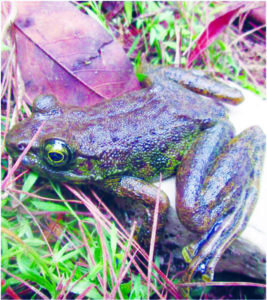By Our Reporter

SHILLONG, May 31: In a discovery that proves nature still has surprises hidden in plain sight, scientists from ZSI have found a brand-new species of frog, Amolops shillong, right in the heart of Shillong.
Amolops shillong, or the Shillong Cascade Frog, which loves fast-flowing streams, has been quietly living in Shillong’s urban forest patches, unnoticed until now. This discovery has now been officially published in the latest edition of the Records of the Zoological Survey of India.
What makes this find special is that it didn’t come from a remote jungle or deep cave. Instead, it came from bustling localities like Mawlai.
“This frog is a reminder that cities like Shillong are not empty of wildlife,” said Dhriti Banerjee, Director of the Zoological Survey of India (ZSI). “Urban areas still hold rich ecosystems, and protecting these green pockets is crucial — for this frog and for the environment as a whole.”
The Shillong Cascade Frog looks very similar to other frogs, but behind its familiar face is a genetic identity all its own. To make sure this wasn’t a known species, researchers used DNA analysis and compared it to other frogs in the Amolops indoburmanensis group.
It turns out that its closest cousin is Amolops siju, discovered in 2023 in the dark depths of Siju Cave in South Garo Hills. But unlike that cave-dweller, the Shillong Cascade Frog prefers splashing around in urban streams. The two species are genetically different enough — by 2.0% to 3.4% — to be classified separately.
Over the course of 2022 and 2023, three specimens of this frog were collected. Two were found in Umthlong, Mawlai by Damepaia Pdah from Assam University, and one came from Umrynjah thanks to Eugene Lyngkhoi, a PhD scholar from NEHU, Shillong.
“We didn’t expect to find a new species in such a busy part of the city,” said Bhaskar Saikia, lead author of the study. “But this just shows how much is still left to discover — even in urban areas we think we know well.”
Frogs like Amolops shillong are more than just cute creatures — they’re indicators of healthy, clean ecosystems. Their presence in Shillong suggests that some parts of the city still have the right conditions to support sensitive wildlife.
“Urban biodiversity is often ignored, but this frog proves we need to rethink that,” said Dr Bikramjit Sinha, one of the study’s co-authors. “It’s a scientific milestone, yes — but more importantly, it’s a wake-up call.”
The scientists stress that documenting urban biodiversity needs to be a priority — especially as rapid urbanisation continues to put pressure on green spaces.
“This species is visually similar to others, which is why it stayed hidden for so long,” said Dr KP Dinesh, another co-author. “But with the help of modern genetic tools, we’ve revealed a whole new species — and there may be many more like it.”
India now has 20 known species of Amolops frogs, 16 of them described from within the country. Amazingly, nine of those have been discovered just in the last 20 years — many from the Northeast, underlining the region’s incredible natural wealth. The Shillong Cascade Frog is a testament to this richness. And its discovery was made possible by a dedicated team of researchers including A Shabman (ZSI, Pune), Eugene Lyngkhoi (NEHU, Shillong), and Damepaia Pdah (Assam University, Silchar), who worked in the field and the lab to bring this hidden gem to light.



